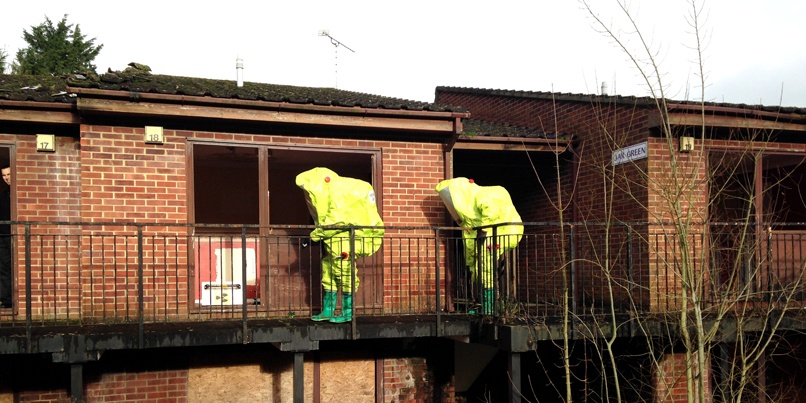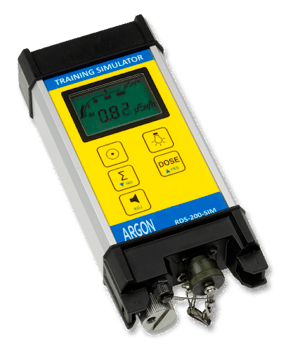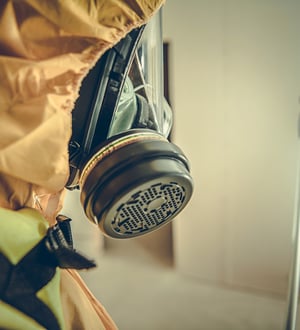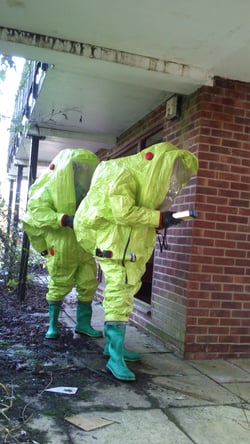
"Nothing can compare with realistic training in the fire and rescue service."
- Ross Smallcombe, Firefighter
Creating realistic first responder training scenarios is an ongoing challenge, especially when planning the practical, hands-on use of highly specialist equipment, such as radiation detectors.
Firefighter Ross Smallcombe saw this firsthand when he was asked to provide the duty crew at the Ryde Fire Station on the Isle of Wight with a short training session on the use of their service's Mirion Rados RDS 200 Universal Survey Meter. He quickly realised that there were some significant gaps in the crew's practical hands-on experience of the device, and needed to find a way to deliver the knowledge they needed.
In this article, we will hear from Smallcombe about how he created a realistic first responder training scenario that successfully delivered a hands-on experience to the duty crew.
The challenge of creating first responder radiation training scenarios
Smallcombe noted one major roadblock when he began planning his first responder training sessions:
"The biggest problem I had was being able to carry out realistic first responder training that gave a real understanding and hands-on approach to radiation," says Smallcombe.
"After visiting the Argon website, I contacted them to enquire about using a Rados RDS200 simulator. Within an hour I was having a conversation with Steven Pike (Managing Director) who was willing to assist me with my plans and loan me a kit which included simulation emitters (both directional and spherical), simulation powders and liquids, the GMP-11-SIM simulation beta contamination probe and EPD-MK2-SIM (personal dosimeters).
"This was fantastic news. Now I could plan a training package based on realistic scenarios whilst evaluating this new equipment."
The opportunity to experience real-time radiation simulation technology through the use of the Rados RDS 200 SIM was to prove an invaluable learning tool for the Ryde Fire Station crew
→ Learn more about radiation training with our guide: An Introduction to Radiation Safety Training
Planning real-experience first responder training

First, Smallcombe stripped the subject back by preparing a lecture about the RadosRDS 200 which covered topics such as its application within varied industries, what it detects, how to use it and its construction.
He then created a second training session covering the basics of radiation, including an overview of the various types of radiation, dose rates, fire service procedures, and a section covering Chernobyl and radiation levels around the disaster zone.
The two sessions were then followed by a short practical hands-on session using the Rados RDS 200 SIM and GMP-11-SIM beta contamination probe.
"The gamma simulation emitters were turned on and beta liquids and powders were used on food to enable the simulation detection equipment to show readings. This was the first time any of us had seen readings on the Rados RDS 200," says Smallcombe.
→ Related: 5 Tools to Enhance the Realism of Radiation Training
The first responder radiation training scenarios Smallcombe created:
Using the RDS 200 simulator, Smallcombe was able to set up a series of realistic,  scenario-based first responder training sessions which included:
scenario-based first responder training sessions which included:
-
Simulating a road traffic collision involving radiation - This was set up to simulate a broken container with a source of radiation inside. Using a directional emitter, EPD-MK2- SIM (personal dosimeters) and RDS 200 SIM, a van was parked and a car was put into position to simulate a rear collision. The car contained a casualty that had leg entrapment. The challenge was to release the casualty and make the area as safe as possible while keeping crew exposure to a minimum.
-
Replicating a school laboratory accident - A series of buildings were set up to simulate the accidental spilling of a radioactive substance. The crew were tasked with rescuing the walking wounded, sourcing and containing the radioactive material and setting up a decontamination process.
-
Locating a source of radiation - Radiation emitters were placed in various locations around the abandoned village and crews in pairs were sent off with the Rados RDS 200 SIM and EPD MK2 SIM. Their goal was to locate the source of the radiation, report back its precise location and to determine how close the team could safely get without exceeding the acceptable radiation dose rate.
- Simulating a casualty fleeing a scene - This scenario was designed to simulate a casualty covered with contaminant fleeing from the scene of a small radiation incident. Beta simulation radioactive contamination powder was placed on windowsills, handrails and flooring within the building. The crew's challenge was to identify and follow the trail to locate the lost casualty.
- Finding safe routes - A casualty was placed within a group of buildings and two radiation emitters were set up to simulate various strengths and direction of radiation. The task for the crew was to locate the casualty within the contaminated area and to map out a safe route through the building.
Using simulation in first responder radiation training scenarios
Simulation training accurately replicates how real devices respond to a range of radiological and / or chemical agents. Intelligent, computer-based simulation tools offer first responder teams a safe, workable and cost-effective training opportunity. 
Says Smallcombe, "The simulation kit enabled us to train in a very realistic and practical way and all crews that were able to be part of the training sessions are now confident and competent with the use of the RDS 200.
"Nothing can compare with realistic training in the fire and rescue service."
Read the full case study from Ross Smallcombe and the Ryde Fire Station.
You can also download our free eBook: A Guide to Best Practice in Radiation Simulator Training, to learn more about typical scenarios to train for and how realism contributes to successful radiation safety training.








